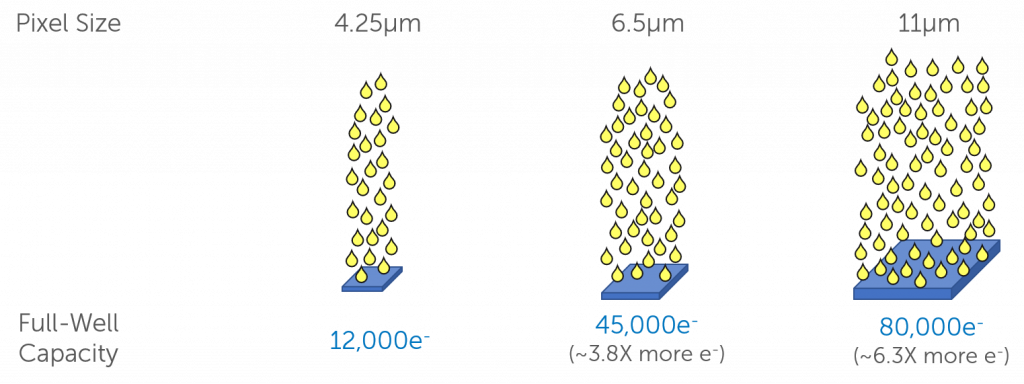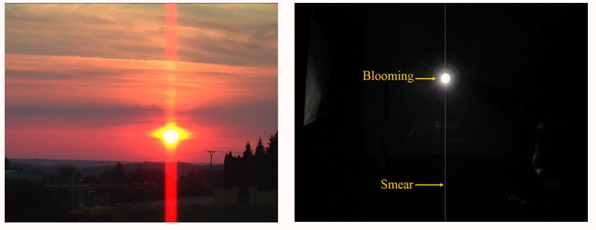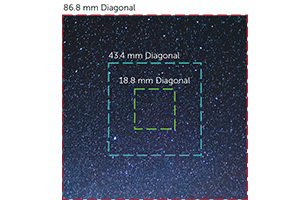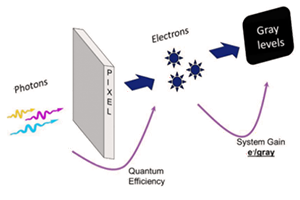Full Well Capacity
Full well capacity is defined as the amount of charge that can be stored within an individual pixel without the pixel becoming saturated. It is dependent on the pixel size of the sensor and the camera operating voltages. This limitation can be an important consideration when choosing a camera.
Figure 1 shows an example of the full well capacity of a camera with a 4.25 μm pixel, a camera with a 6.5 μm pixel, and a camera with a 11 μm pixel. This example shows how the full well capacity increases with pixel size. Overall, the full well capacity increases with pixel size, as shown in Figure 1.

Pixel Saturation
Saturation is a phenomenon which occurs when an individual pixel is no longer able to store any more charge (i.e. cannot accept any more photoelectrons). If each pixel can be assumed to be a well of electrons, saturation occurs when this well is full.
The maximum charge that can be stored within a pixel is largely determined by its area, however as the charge is stored within a potential well, the probability of trapping an electron within the well reduces as it approaches saturation.
Therefore, the linear relationship between light intensity and signal degrades as the pixel approaches the saturation limit. This results in an apparent responsivity of a “saturated” pixel drop. Well capacity is sometimes referred to as the linear full well. This is the point at which the linearity between light intensity and signal degradation exceeds an acceptable level, not when the pixel is at its ultimate saturation limit. Cameras are usually designed so that this signal level fills the full dynamic range of the analog-to-digital converter.
Blooming
At saturation, pixels are unable to hold any additional charge, so instead this charge is spread into neighboring pixels. This causes either errors within measured signal or saturation within neighboring pixels also. This spread of charge is called blooming and is visualized as a white streak or blob in the image.
During CCD readout, the excess of electrons from the saturated signal is moved down the sensor resulting in a vertical streak or smear down the image, further disrupting image acquisition.

There are several different types of antiblooming structures to reverse these effects, however two of the most common are fixed and gated. Fixed antiblooming structures incorporate a drain that runs next to the pixel with a barrier between the pixel and drain. If the charge in the pixel fills to the height of the barrier it will overflow into the drain preventing charge from flowing into a neighboring pixel. Gated antiblooming uses a gate type system in which the barrier can be open or closed. This is controlled by pulses which are sent to the gate by the user. If open, the gate allows any charge in the pixel to flow into the drain.
Summary
Full well capacity is the amount of charge that can be stored within an individual pixel without saturation. It is dependent on pixel size and camera operating voltages.
When a pixel is saturated it is no longer able to store any more charge. As a pixel approaches its saturation limit, the linear relationship between light intensity and signal degrades. This results in a “saturated” pixel drop.
At saturation, charge is spread onto neighboring pixels as the saturated pixel cannot hold any additional charge. This spread of charge is called blooming and is visualized as a white blob or smear on an image. During readout, the excess of electrons from the saturated signal is moved down the sensor, resulting in a vertical smear.
Antiblooming structures can be implemented to prevent blooming effects. The two most common are fixed and gated, in which a fixed structure incorporates drains around each pixel to remove excess charge. A gated structure uses a barrier which can be manually switched to open or closed. If open, the barrier allows any charge to flow into the drain.


